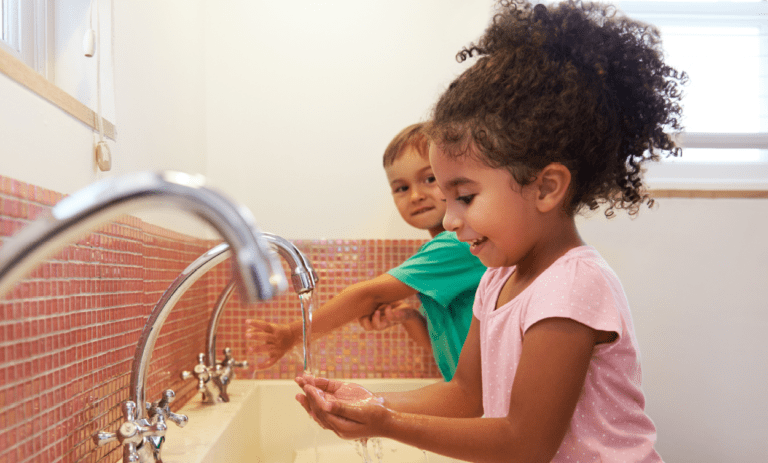Parents send their children to school with the expectation they will receive an education, and they’ll remain emotionally and physically safe while that happens. Because of this, many restroom facilities in K-12 schools are a constant source of trouble. From unsanitary conditions, to being a prime bullying location— all the way to the long term health effects of avoiding restrooms —dirty restrooms can have a significantly detrimental effect on student health and learning.
“79% of respondents recognized the link between poor toilets and poor health, and 84% felt toilet-related health issues have a negative effect on children’s learning.” — A survey of schools and school nurses, ERIC, 2010.
Given how often adults avoid unsanitary public restrooms, it makes sense that students often avoid school restrooms. However, while adults often have the ability to choose and visit a restroom of their choosing, students are, on average, at schools for 7 hours a day with only school restrooms to use. Avoidance of restroom use because of sanitation issues can negatively impact both health and learning.
Nursing Times reports, “A survey of schools and school nurses conducted by ERIC in 2010 found 79% of respondents recognized the link between poor toilets and poor health, and 84% felt toilet-related health issues have a negative effect on children’s learning.”
Policies on restroom visits and the conditions of the restrooms themselves can both deter students from using them. In 2018, a survey created by the Society for Women’s Health Research revealed a majority of school nurses said their schools lacked written policies regarding students’ restroom use. In addition, the condition of school restroom facilities and frequency of their maintenance can vary widely from one district to another. Unlike adults, school children often have no say in the cleanliness of the restrooms they have has access to.
EXAMPLES OF HEALTH EFFECTS
When students avoid unsanitary and smelly restroom facilities, it can create a variety of problems. Students may be tardy after searching out a cleaner restroom. They may avoid eating or drinking so as not to use the restroom during school. They may even “hold it” for long periods of time, which can lead to LUT and gastrointestinal health issues, as well as decreased focus and poorer learning outcomes.
Dehydration
Visits to the restroom can be difficult for students. Students are often expected to fit water and restroom breaks in the short times they are given to travel to their next class. Crowded hallways or a visit to their locker can make this even more challenging.
To avoid restrooms deemed unsanitary and to avoid being late, many students report reducing their intake of water or other drinks, potentially leading to dehydration.
Dehydration can cause serious symptoms that detract from learning: fatigue, dizziness, poor concentration and reduced cognitive abilities. The human brain is made up of 80% water, and as a result water is essential in neurological transmissions. On a cellular level, poor hydration reduces the brain’s ability to transmit and receive information.
Once a student is dehydrated enough to notice they are thirsty, their mental performance including memory, attention and concentration have all decreased by as much as 10 percent.
Urinary Health Issues
Even when students are hydrated enough, avoiding urination can also cause problems, such as lower urinary tract health issues, not to mention affecting a student’s ability to concentrate in class.
According to the Urology Care Foundation, the bladder stays healthy when it fills and empties without getting overfull. And holding urine for too long too often can cause lifelong problems carried into adulthood.
While educational institutions can have several areas of concern in regards to urinary health, restrooms play a vital role. A 2014 electronic cross-sectional survey among teachers, as reported in the National Center for Biotechnology Information, indicated 88 percent of respondents (4,166 teachers) encourage students to hold urine, which “can promote or exacerbate LUT dysfunction.” The survey also reported dirty restrooms as an issue by a third of respondents.
Dehydration can cause serious symptoms that detract from learning: fatigue, dizziness, poor concentration and reduced cognitive abilities.
Gastrointestinal Health Issues
The avoidance of restrooms can also lead to gastrointestinal issues, such as chronic constipation or incontinence, in younger school children. Stinky toilets, no supplies, dirty floors and walls, and lack of privacy are all reasons children give pediatricians for not using school toilets. This can be problematic both in the classroom and at home, because it can set back potty training behaviors and mean a resurgence in accidents.
Spread of Germs
Unhealthy conditions lead to unhealthy schools thanks to the accelerated transmission of germs and bacteria. Given what goes on in restrooms, toilets, floors and tiled walls can harbor a whole host of bacteria, such as Norovirus, E. coli, Shigella, and Streptococcus. But avoiding restrooms can lead to an additional issue: A lack of hand washing.
Washing your hands after you use the restroom isn’t just for germs introduced in the restroom – washing your hands after using the restroom is a way to ensure that the germs and bacteria that get on your hands in day-to-day activity are removed throughout the day.
With nearly 22 million U.S. school days lost to the common cold each year and 38 million lost to the flu, it’s within educators’ best interests to invest in procedures and policies that keep school restrooms safe and sanitary throughout the school year.
Cubix Inc.’s Saniglaze Solution
SaniGLAZE has been used by educational facilities for decades as a way to dramatically improve the condition and appearance of their tile and hard surfaces—for a fraction of the cost of replacement.
The multi-step restoration process allows schools to sidestep the high cost of ripping out and replacing unsanitary, damaged tile, and instead remove contaminants and instead remove contaminants, ensuring tile and hard surfaces stay cleaner for longer with the custodial efforts that are already happening day-to-day.
Contact Cubix, Inc. to schedule a free consultation where you can learn which services are best for your facility’s needs, whether that’s intense cleaning, advanced floor, and wall shielding, or a myriad of eye-catching design options to brighten the moods of students and staff.

Travis Owens, the President of Cubix, Inc., has dedicated over 18 years to refining and leading the premier leader for commercial flooring services in Florida. Before taking the helm as President, Travis excelled as the Director of Operations, solidifying his reputation as an industry trailblazer in commercial flooring consulting and solutions. A proud veteran, Travis honorably served 8 years in the Marines, exemplifying his commitment and discipline in all endeavors. Residing in Orlando with his family, he also indulges in his passion for culinary spices.







